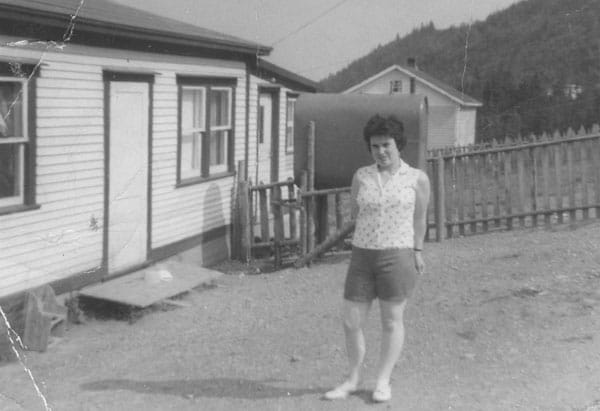History in every nail, memories at every turn; when a house reflects its owner's life, its value is priceless.
My nan's house is as familiar as my own. As children, my cousins, aunts and uncles (some older, some younger than I) explored every corner and cranny. From the root cellar that was dark and damp enough to twist our imaginations, to the kitchen with its rich perfume of fresh homemade bread, there was no better playground.
Visitors to the area could never guess the rich history of this four-bedroom bungalow located in Benoit's Cove, a small community about 20 minutes south of Corner Brook, on Newfoundland and Labrador's west coast. How could they know that the house was truly built to last, unlike many more modern, more impressive homes? That it was built with the best timber my grandfather could harvest, with patience and love mixed with blood, sweat and tears? That the house passed a test that many of today's houses might not structurally withstand?

The story of this house began more than five decades ago, on Woods Island, once the centre of commerce for the Bay of Islands. Settled in the late 1800s by men drawn to the bay's rich fishing grounds, at its peak the population of Woods Island swelled to several hundred. There were schools, churches and sawmills, a customs office, general stores and lobster factories. Gertrude (Hickey) was 17 when she married 20-year-old Ignatius (Nick) McCarthy in 1946. The newlyweds immediately set out to build what would be their first and only home-a daunting task given the island's spare woodlands, not to mention that all building supplies (everything from nails to windows) had to be purchased off the island and transported over water.
"Nick would go to North Arm or into the Blow Me Down Mountains to cut wood. He'd fill the boat with whatever it could carry and then drag the rest of the wood in the water behind the boat," Gertrude McCarthy recalls, cradling a steaming cup of sweetened tea.
"He'd take the wood to the saw mill and then bring it home to dry for a few days. Sometimes he would get the wood sawed on "the halves" meaning that he would take half the wood and the sawmill would take the other half as payment.
"Every nail that was drove I was there with him," she adds. "That's how we built our house."
Three years would pass and three children would be born before the couple left a relative's house for their own.
"The day we moved is the best memory of my life," the 78-year-old great-grandmother and widow remembers. "Nick took the crib; I took the baby and we walked into the house with our three kids. It was so clean and shiny and it smelled like wood.
"We had a kitchen and a bedroom," Gertrude recalls. "There was nothing on the walls but the boards; nothing on the floor but wood. There was no loft, just a roof with sticks across it. We put slabs over the beams, stuck paper on with paste and painted it. I thought I'd died and gone to heaven. It was mine."
Most homes on Woods Island were built in much the same way. Only the craftsmanship and the materials gleaned from the natural surroundings set them apart. Years later, Nick McCarthy would develop a reputation as a boat builder with a keen eye for selecting the best materials nature had on offer. Evidence of that is found in his own home, which in 40-plus years was moved twice before coming to rest at its current location in Benoit's Cove.
Children living in Woods Island Harbour had to walk to the other side of the island to attend the Catholic school-a cold trek during the frosty winter months. Eventually Nick and Gertrude decided to move their home, which they had expanded to include three bedrooms. It was the mid-1950s.
"We put the house in the water and we had it towed from one end of the island to the other," Gertrude says, the cup of tea growing cold as her story takes hold. "The only damage was the wallpaper that soaked off the walls in some places, but that was easy to replace."
Between the 1950s and 1960s Woods Island was targeted under former Newfoundland Premier Joey Smallwood's centralization strategy. All over the province rural towns disappeared as families moved to larger centres. Some had already left Woods Island; others fought to stay. But life as the island residents knew it was changing. It was increasingly difficult to get teachers and priests to stay there. In 1960, Gertrude and Nick decided to move again.
Moving the family home was fairly common during the days of resettlement. Houses set on barges were towed across bays and inlets. Some Woods Island residents received $600 from the provincial government to offset their expenses. Gertrude remembers neighbours helping each other manoeuvre their homes onto the beach, rolling their houses on "slips" made of wood. Nick designed a cradle that, when hoisted onto the barge, would keep much of the salt water away from his house. Windows were removed and ropes woven into their gaping frames to tie the house to the cradle, the barge beneath and the boat that would tow the house. Inside the building, nails and more rope secured movable objects.
On a calm September evening in 1960 the McCarthys were ready to set sail. The three oldest children remained overnight on Woods Island, but Gertrude wanted to take her four youngest with her. Crossing the bay "was quite an adventure," she says.
"I boiled the kettle on the boat but we ate in here," she explains, indicating the kitchen in which she is sitting. "I put the baby asleep in one of the rooms but the other kids were too excited. They wanted to see what was going on."
The house arrived at the government wharf in Benoit's Cove without mishap after dark, but could go no further.
"That's when the house settled and the walls got wet," Gertrude says. It was moved the next day to the land Nick had selected-close to the Catholic Church and the local school.
"The older children had to go to school in Corner Brook and the bus cost $10 a month," Gertrude recalls. "We couldn't afford that so we built on a section and started a small store. I ran that for four or five years and I enjoyed it. When I gave up the store the space became our living room."
After the move, the family increased from seven children to 11. Nick upgraded the walls with gyproc, plaster and paint. Today, there are tiles on the ceiling and laminate flooring. A finished basement has been added; new windows replaced the old. Gertrude's computer hums in one corner. But it's the kitchen and the dining room that really give this house its character. Cosmetic changes aside, they, along with the master bedroom, remain pretty much as they were when the house was built.
"A lot of hardship and work went into this house," my grandmother says as we page through albums of black and white photos; the images helping her recall stories of the home.
"Nick always said that if something was worth doing then it was worth doing right. Whoever buys this house might have to do a few repairs but they'd be getting a strong old house."
A house with history built into its very walls.
